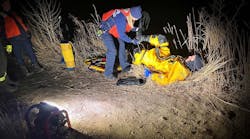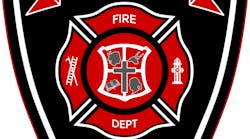Today's fire and EMS vehicles are just basically a rolling emergency room that makes house visits multiple times a day. In years past we have had a worries about infectious disease transmission, but in today's world we must stop and not only be patient advocates, but protect ourselves. Infectious disease is defined as an illness resulting in exposure to a pathogenic microbial. Most of these germs are invisible to the human eye and can infect you before you are even aware that you are getting exposed. From airborne viruses to injected bloodborne pathogens, the danger's that come with medical response are everywhere. You must always treat what you can and cannot see and what you do and do not know about.
During the development of EMS or first responder programs it is important to educate your members on the risks and routes of exposure they may face. Education starts on the first day that your organization puts a crew and vehicle on the road that will be caring for patients. First responders must also understand that they go into homes, business and other locations that are full of these diseases. Education must be continued with every new threat that is announced. As an example, with the recent H1N1 outbreak everyone scrambled to vaccinate and protect our responders, search for information to protect others, and ways to keep from contracting it. A good first step is assigning an infectious disease officer to monitor and educate your department. The information is communicated daily on all old and new diseases from sources such as the CDC and your local or state health department.
Once the first few steps are set in place, you can work with your medical physician on staff to set policies and guidelines in place. Most all of our services are directed and controlled by a local physician. It is important to select a doctor that is active with your organization in all aspects of your service, especially the infectious disease program. With most medical directors being emergency room physician's they should be on the frontline treating a new threat and can inform us if it has the potential to affect responders. If your medical director isn't a emergency room physician it is important to use your local or state EMS office to keep you posted of potential threats.
I would use today's technology to work for you in keeping touch with risks. A quick e-mail or text message could alert you for a needed procedure change.
Now that you have established a relationship with the local or state health department and your medical director it's time to discuss what your policy should do. A few quick points to get you started in making your procedures are:
- How to protect our responders from exposure
- Routes of exposure
- What type of vaccines are required or recommended
- How to handle an exposed responder
- What type of long-term plan to follow up on an exposed responder
- Establishing a reporting system for exposures
- Planning for continuing education on infectious diseases
These are just a few brief ideas to help you establish your department's infectious disease policies and procedures. Once again, it is very important to use outside sources and possibly reference other departments in establishing your policy. It's not the time to reinvent the wheel but it is important to tailor your procedures to your department's needs. For example, if you are an EMT-basic or first responder and are responding to emergencies with another agency providing advanced life support it is important to educate your responders on IV needle safety. This is an example of tailoring your procedures to educate your responders to a slightly higher level before the come in contact with a potential exposure risk that they may have not seen.
The men and women of our profession make a difference in many lives each day. We owe it to them to establish, educate, and maintain a strong infectious disease policy to protect them and their families, as well as protecting each other and ourselves. With everything from H1N1 to HIV, exposures can affect us when we are least expecting. By using universal precautions and treating each and every patient as a potential risk for exposure we can protect ourselves and everyone around us.
Thank you for being who you are and caring enough to read and learn more about ways to make your department better. Remember to take a moment during the 2010 Fire/EMS Health, Safety & Survival week to review what you can do to make your next EMS run safer. Be safe everyone and thank you for serving!
RYAN PENNINGTON, a Firehouse.com Contributing Editor, is a firefighter/paramedic with the Charleston, WV, Fire Department. He is currently assigned to Station 7 and a member of the West Virginia Task Force 1 USAR team. He has over 15 years of combined fire, rescue and EMS experience. Ryan is currently a West Virginia State Instructor 2, Hazmat Technician, and Certified Fire Officer 2. Ryan was a guest on the Engine Company Operations in Today's Buildings podcast on Radio@Firehouse. You can reach Ryan by e-mail at [email protected].





